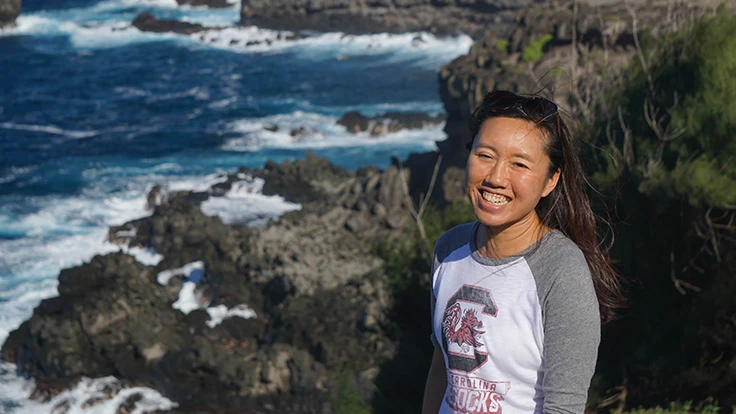

As the grower at Pang’s Nursery in Kahalu’u, Kaneohe, Hawaii, on the island of Oahu, Emily Teng gets to work outdoors, surrounded by the Hawaiian tropics with breathtaking views of the Ko’olau Mountains.
But lately, Teng has been spending a lot of time indoors as she completes her PhD in ornamental horticulture. She works part-time at Pang’s one day a week so she can focus on her research at the University of Hawaii (UH) in Manoa. Balancing school and work isn’t easy, but Teng says learning is critical to her career.
“You need to stay curious as a grower,” says Teng, who started working in the horticulture industry in 2002. “Our field is always changing. There are always new products, new plants and new processes, and if you don’t keep up with all these things, you won’t know what’s happening.”
After she graduates next spring, Teng wants to do research and product development for a large plant breeder. Until then, she’s balancing her time between Pang’s Nursery and UH to share her horticulture expertise.
(Editor's note: Find out how Teng first got into the horticulture industry 17 years ago while working as an IT consultant in South Carolina.)
Growing remotely
Teng started working at Pang’s Nursery in 2007, after she earned her master’s degree in ornamental horticulture from UH. She switched to part-time when she went back for her PhD in 2013.
“Working at the nursery keeps me in the loop and in tune with real life outside of school,” Teng says. “I don’t want to lose touch with growing.”
The family-owned wholesale nursery employs four other people dedicated to planting, packing and delivering plants, but Teng is the only grower on staff. One of her main responsibilities is pest and disease management — which can be a challenge, since the growing operation is completely outdoors, located on a mountainside with one covered area but no enclosed facilities. The property covers 4 acres, but the actual growing space is less than half that.
In this tropical location, Teng says, “insects are a constant battle.” Plus, the nursery is in a wet part of the island where flooding is common, so moisture also contributes to fungal and bacterial disease that can spread quickly. Teng relies on preventative spraying and scouting, but since she only works one day a week, the nursery owner picked up some of these duties. It’s critical that they communicate frequently to stay on the same page.
“We created an Evernote file that we share to keep track of everything so we can both update it,” Teng says. “I’ll take notes and pictures to record what I sprayed, when it flowered and how it turned out. So if I’m not there, she doesn’t have to remember what we did last year because it’s all in the file.”
As simple as it seems, Teng says the shared file is key to working remotely because she and the owner can share and access information anywhere.

Engaging students
Teng’s outdoor growing experience gives her an advantage in the lab at UH, where she’s researching how light and temperature affect poinsettia bract pigments.
“I’ll see younger students growing in the greenhouse and they’re having all these pest problems that they don’t know how to deal with. I’ll be like, ‘Oh, you just need to spray this,’” Teng says.
Over the past few years, Teng has gotten more involved in the horticulture department by spearheading student events like the annual fundraiser.
“The department has been doing a poinsettia sale every Christmas for years. It used to be that the undergraduates would just buy plants wholesale from a local nursery and then sell them,” Teng says. “Then in 2016, the graduate students got involved and decided we were going to grow our own. And because I have all this experience, I got to be in charge of that.”
Teng manages poinsettia production in UH’s student greenhouse. Breeders donate most of the cuttings and funds from the plant sale support student activities throughout the year.
“We’re plant science students. We should be growing our own plants, not buying them,” Teng says. “Because we’ve been growing them ourselves, the quality has improved and we’ve been able to charge a little more. We’ve actually been selling out much faster, so it’s been really successful.”
Additionally, Teng coordinates other student events and activities. Last February, she organized a plant sciences symposium about communicating scientific innovations. These events give her an opportunity to engage with younger horticulture students — especially shy students who thought plant science just meant working in a lab.
“When I was their age, I was like that too,” Teng says. “I was shy, quiet and reserved. I didn’t get out and talk to people. But in the past few years, I’ve been getting involved and meeting all these people, so I try to tell students that [networking] really does help. You meet people and make new friends and you always run into them later. That’s why it’s a fun industry to be in.”

Explore the May 2019 Issue
Check out more from this issue and find your next story to read.
Latest from Greenhouse Management
- Anthura acquires Bromelia assets from Corn. Bak in Netherlands
- Top 10 stories for National Poinsettia Day
- Langendoen Mechanical hosts open house to showcase new greenhouse build
- Conor Foy joins EHR's national sales team
- Pantone announces its 2026 Color of the Year
- Syngenta granted federal registration for Trefinti nematicide/fungicide in ornamental market
- A legacy of influence
- HILA 2025 video highlights: John Gaydos of Proven Winners





